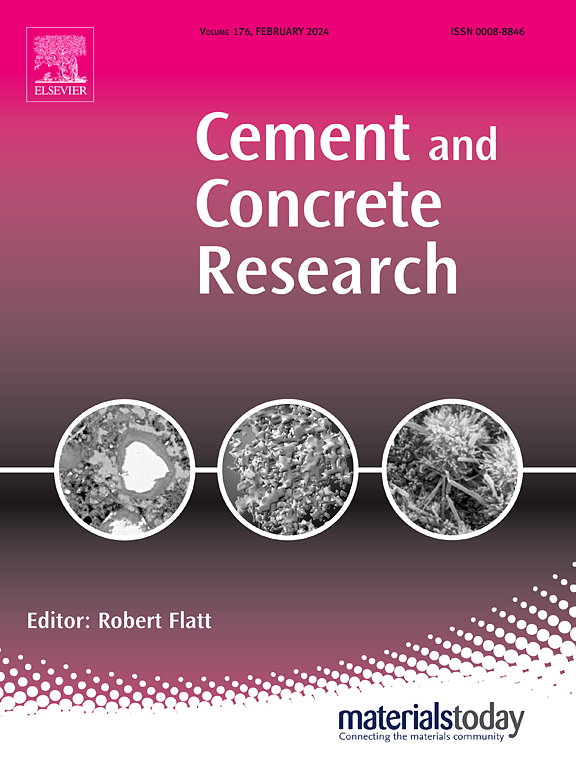大小和含量依赖的二氧化硅颗粒对水合铝酸三钙-硫酸盐相互作用的抑制作用
IF 13.1
1区 工程技术
Q1 CONSTRUCTION & BUILDING TECHNOLOGY
引用次数: 0
摘要
在胶凝材料中掺入纳米级或微米级二氧化硅已被证明可以显著增强抗硫酸盐侵蚀的能力。尽管有这些好处,但这些改进的确切机制尚未完全了解,特别是关于硫酸盐暴露下混合水泥中未水化二氧化硅颗粒的作用。铝酸三钙(C3A)是水泥的关键成分,在易受硫酸盐侵蚀的铝相中占很大比例。本研究研究了不同尺寸的二氧化硅颗粒如何影响C3A水合物与硫酸盐溶液之间的相互作用。通过对反应产物、微观结构形态、离子浓度、zeta电位和溶液中硫酸盐浓度的定性和定量分析,建立了新的影响机理模型。这些发现表明,C3A水合物和硫酸盐体系中的纳米级二氧化硅(NS)颗粒阻碍了水榴石与硫酸盐的反应,从而减少了钙矾石的形成。NS主要抑制水石榴石的溶解,降低Ca2+和Al3+离子浓度,减少SO42−离子的消耗。这种抑制是由于NS在水榴石表面的吸附,NS吸引Ca2+、SO42−离子或CaS离子对,导致表面离子过充,从而减少水榴石的溶解。此外,NS颗粒粘附在钙矾石表面,阻止Ca2+、SO42−或CaS离子对的吸附,从而抑制钙矾石的形成和生长。这种影响主要取决于二氧化硅的存在,因为二氧化硅的微尺度或二氧化硅的不足会减少或消除这种影响。这些发现为使用纳米材料增强水泥基材料的耐久性提供了见解,并为该领域的未来研究奠定了基础。本文章由计算机程序翻译,如有差异,请以英文原文为准。
Inhibition of tricalcium aluminate hydrate–sulfate interactions by size and content-dependent silica particles
The incorporation of nanoscale or microscale silica into cementitious materials has been demonstrated to markedly enhance resistance to sulfate attack. Despite this benefit, the exact mechanisms responsible for these improvements are not yet fully understood, particularly concerning the role of unhydrated silica particles in blended cement under sulfate exposure. Tricalcium aluminate (C3A), a key component of cement, contributes a substantial proportion of the aluminum phases that are vulnerable to sulfate attack. The present study investigated how silica particles of varying sizes influence the interactions between C3A hydrates and sulfate solutions. By conducting qualitative and quantitative analyses of the reaction products, microstructural morphology, ion concentrations, zeta potentials, and sulfate concentrations in the solution, a new impact mechanism model was developed. These findings reveal that nanoscale silica (NS) particles in the C3A hydrates and the sulfate system impede the reaction between hydrogarnet and sulfate, thereby reducing ettringite formation. NS mainly suppresses hydrogarnet dissolution, resulting in lower concentrations of Ca2+ and Al3+ ions and reduced consumption of SO42− ions. This suppression is attributed to the adsorption of NS on the hydrogarnet surface, and NS attracts Ca2+, SO42− ions, or Ca![]() S ion pairs, leading to surface ion overcharging and thereby reducing hydrogarnet dissolution. In addition, NS particles adhere to the surface of ettringite, preventing the adsorption of Ca2+, SO42−, or Ca
S ion pairs, leading to surface ion overcharging and thereby reducing hydrogarnet dissolution. In addition, NS particles adhere to the surface of ettringite, preventing the adsorption of Ca2+, SO42−, or Ca![]() S ion pairs, thereby inhibiting ettringite formation and growth. This effect is notably dependent on the presence of NS, as microscale silica or insufficient quantities of NS lessen or eliminate the impact. These findings provide insights into the use of nanomaterials to enhance the durability of cement-based materials and establish a foundational basis for future research in this area.
S ion pairs, thereby inhibiting ettringite formation and growth. This effect is notably dependent on the presence of NS, as microscale silica or insufficient quantities of NS lessen or eliminate the impact. These findings provide insights into the use of nanomaterials to enhance the durability of cement-based materials and establish a foundational basis for future research in this area.
求助全文
通过发布文献求助,成功后即可免费获取论文全文。
去求助
来源期刊

Cement and Concrete Research
工程技术-材料科学:综合
CiteScore
20.90
自引率
12.30%
发文量
318
审稿时长
53 days
期刊介绍:
Cement and Concrete Research is dedicated to publishing top-notch research on the materials science and engineering of cement, cement composites, mortars, concrete, and related materials incorporating cement or other mineral binders. The journal prioritizes reporting significant findings in research on the properties and performance of cementitious materials. It also covers novel experimental techniques, the latest analytical and modeling methods, examination and diagnosis of actual cement and concrete structures, and the exploration of potential improvements in materials.
 求助内容:
求助内容: 应助结果提醒方式:
应助结果提醒方式:


